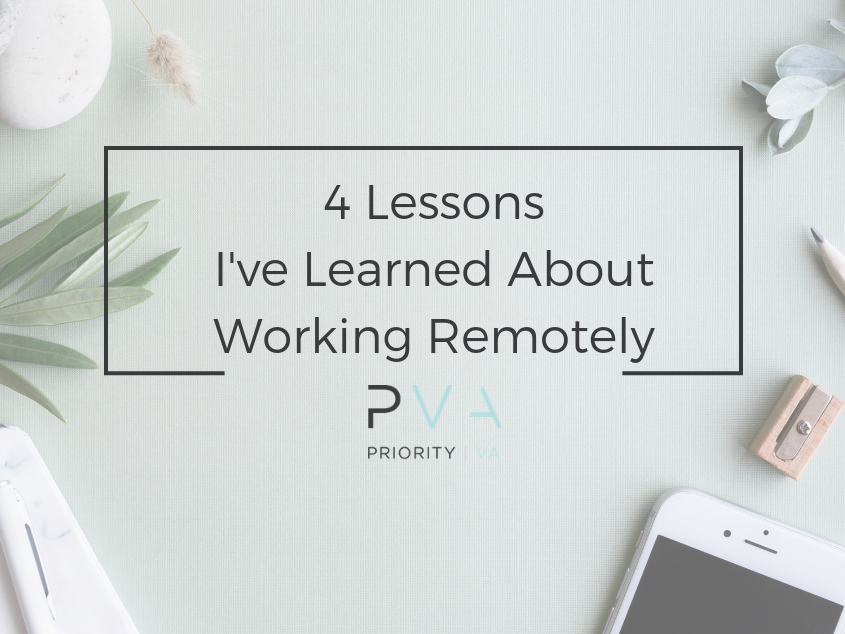Working from home is a desirable scenario for many employees. Remote work usually offers flexibility in your schedule, and considerable time savings from not having to commute to and from an office. The arrangement is beneficial for employers, as well. Remote workers expand your field of talent from anywhere in the country, and can save you money on physical office space.
There’s no question, telecommuting requires intentionality and self-discipline from the home worker. It can be challenging to put yourself in a professional mindset without others physically working around you. Not to mention there is nobody around to see if you are in a blazer, or pajamas.
Nationally, interest in remote work is on the rise. Virtual Vocations Year End Report (2017) says that 80 to 90% of U.S. professionals want to work at home at least part-time. The same report shows that since 2005, there has been a 115% increase in regular remote work arrangements among non-self-employed professionals.
Before you consider trading in your cubicle for a laptop and headset at home, here are four things we’ve learned about working remotely.
There is no substitute for culture
Workplace culture can range from how a business looks and how employees dress, to team attitudes and pace of work. When working at home, you are isolated from the visual components of workplace culture. What remains is the attitude, communication style, pace of work and relationship between team members.
At the beginning of a work-from-home arrangement, these cultural components might not seem very important. In fact, after years of being subjected to someone else’s cultural preferences, it can be refreshing and empowering to choose how and where you work — whether that is in complete silence at your kitchen table, or in a public co-working space with lots of activity. But in time, working remotely can feel a lot like working on an island. There are no in-person water cooler conversations, spontaneous trips to the coffee shop with coworkers, or lunch outings with your team. The culture you experience is strictly through a technological interface.
The screen separates you from human interaction that is critical to team bonding and relationship. If your employer is not intentional about fostering culture in spite of these technological limitations, working from home can be a very isolating and demoralizing experience.
However, some simple practices can change that. Ask to video chat as often as possible to increase facetime with team members. Dedicate a channel of communication to water cooler conversations and personal chit chat. Find out if there is ever an opportunity to unite with the team in person, such as an annual meeting. Anything to prevent not only social, but opportunity isolation.
Boundaries with work-life balance
Studies show that remote workers work just as hard, if not harder, than their intra-office cohorts. They take less breaks, have fewer sick days, and take less time off. It might be assumed that remote workers approach assignments at a leisurely pace, but we have found the opposite. Intrinsically motivated telecommuters actually work faster out of fear of looking like they aren’t pulling their weight.
If you think about it, nobody is able to witness you working at home unless you are sending emails, responding to chats, making phone calls and delivering on assignments. There is a greater pressure to be “on” when you are physically removed from an office to show you are contributing as much as your team.
The problem is that this mentality contributes to burnout. From an employer’s point of view, the remote worker is meeting or exceeding expectations. But from the remote worker’s point of view, they are probably working through lunch at their desk, or logging on to complete assignments before or after traditional office hours. There is no in-person accountability to prevent overworking. Technology makes this harder too, as most communication apps can connect to your phone.
A study by Teem said 49% of survey respondents were unhappy with the obligation to remain available for communication through today’s tools. To help combat this “always on” remote culture, we have found it best when employers communicate their expectations. If you are juggling a remote staff with multiple time zones, be clear about the expected hours of operation. That way, remote workers can have a stronger sense of when to unplug.
Self Reliance v. Asking for Help
In any work setting, you will inevitably hit bumps in the road while working on assignments or with a certain technology. We’ve learned that remote workers often take it upon themselves to try to troubleshoot the problem as best as they can before asking for help. One reason is because it is more practical. You can’t swing by the IT desk or ask the “office techy” to take a look at your computer. Not to mention, trying to troubleshoot a technological problem through video chat is challenging.
Learning self-reliance is a great quality, because oftentimes 15 minutes of Googling a problem can result in a solution. It is empowering to know you are capable of navigating challenges independently. However, this shouldn’t discourage you from asking for help. We have found that some remote workers need encouragement to reach out when they have a problem that requires a second set of eyes, as well as a chain of command for who to ask. Some employers find it helpful to assign a mentor to the remote worker during the onboarding period so there is a consistent point of contact when troubles arise. This can help motivate a collaborative environment that encourages autonomy as well as teamwork.
Feedback is critical
Every employee, remote or in-person, needs feedback. In a 2014 Harvard Business Review study, 72% of respondents said they thought their performance would improve if their managers would provide corrective feedback. Furthermore, 92% agreed with the assertion, “Negative (redirecting) feedback, if delivered appropriately, is effective at improving performance.”
While this study shows that both positive and negative feedback is welcomed by employees, remote workers can become isolated from feedback simply because they are out of sight, out of mind. It’s hard enough for employers to remember to celebrate a team’s strengths when everyone is in the same office building, so the task requires even more intentionality for the telecommuters.
Just as remote workers desire feedback from employers, we’ve learned they also appreciate means for sharing feedback with employers. Telecommuting is a lot like being in a long distance relationship. When both parties are confined to virtual communication, there are infinite opportunities for miscommunication. Because of this, we’ve learned that remote workers thrive when feedback is a two-way street.
Working from home is a tremendous opportunity with so many benefits. If you consider these four lessons as both an employer and a remote employee, the telecommuting relationship will be mutually beneficial.
When you are ready to see what working with a virtual assistant could look like for you, click here to get started with Priority VA





